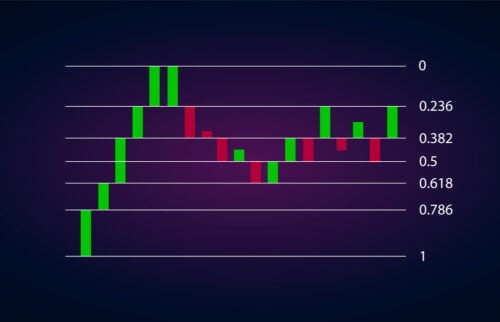Swing trading depends on predicting stock trends, and penny stock prices are notorious for wild fluctuations. So can you swing trade penny stocks? This article will teach you all about how to swing trade penny stocks!
About Penny Stocks
Penny stocks are company shares that trade for less than $5.
There are some characteristics common to most penny stocks, such as high volatility, low trading volume, low stock float, and of course, low price.

Penny stocks are often traded over-the-counter (OTC) through broker-dealers.
This is because most do not meet the criteria to be traded on exchanges, like the NASDAQ or NYSE.
However, not all OTC stocks are penny stocks. Foreign stocks like Nintendo are traded over the counter.
What Is Swing Trading?
Swing traders use technical analysis to identify trading opportunities in the short to medium term without considering the fundamentals of the company (in most cases).
These investors analyze a stock’s movements to identify trends and patterns, predict whether a stock might move up or down, and set up positions accordingly to profit from the movement.
Swing trading can be leveraged with both volatile and less risky stocks. Either way, the objective is to identify where the stock might move next.

How Long Do Swing Traders Hold a Position?
Swing traders create positions that last for more than one session (unlike day traders). These positions might last several weeks or even a couple of months.
Here’s a quick analogy to help you understand the three main types of trading: day trading, swing trading, and long-term trading.
Let’s start by looking at day trading and long-term investing.
Day traders can be thought of as 100 m sprinters who close out their positions within a single session. Sometimes they hold positions for just a few minutes.
Long-term investors are like marathon runners who can wait for years to let a stock grow to its full potential.
Swing traders lie somewhere in between these two extremes. Their investing style is more akin to 10k runners. Swing traders’ positions open and close within a band of a few weeks or months.

Is Swing Trading Easy?
Swing trading is comparatively easier than day trading because it does not require maintaining a constant vigil on the stock price.
As positions take a few days or weeks to mature, there is no need to constantly check prices.
For some people, this form of trading is easier than long-term trading as well.
Long-term traders do rigorous fundamental analysis including industry analysis, competitor analysis, studying balance sheets, analyzing market shares, checking revenue streams, open contracts, sales pipelines, profitability ratios, and much more.
On the other hand, swing trading mostly follows movement charts and indicators to track stock price fluctuations. It does not involve understanding the whole ecosystem of the company.
Can You Swing Trade Penny Stocks?
Yes, you can swing trade penny stocks by taking positions over a few days or weeks, it is a bit easier than day trading penny stocks.
It is very difficult to predict trends or spot movements during a single day with penny stocks, so day trading is not a suitable investment strategy for them. Though, some people day trade penny stocks.
Penny stock prices are so low that even a small movement becomes a big percentage change. Therefore, there is a higher potential for returns in trading penny stocks.

These two factors (more discernible trends over longer periods and high revenue potential) come together to make them a strong candidate for swing trading.
Even better, penny stocks have become much more accessible to trade with the advent of online brokers.
Many apps such as TD Ameritrade and E-Trade let investors trade on OTC penny stocks and provide solid tools for analyzing market movements.
How to Swing Trade Penny Stocks?
It is best to swing trade penny stocks based on technical analysis rather than fundamental analysis.
Penny stocks tend to be so volatile that most price movements have almost nothing to do with company fundamentals.
There are a few swing trade strategies that are more suited to penny stocks, which we will discuss below.
What Are the Best Swing Trading Strategies?
The three main penny stock trading strategies for swing trading are:
- Fibonacci Retracement
- Momentum Trading
- Trading the News
Before we explain these, let’s talk about some key concepts — upward trends (bullish stock), downward trends (bearish stock), and support/resistance during periods of no significant trend.
When a stock moves up but keeps coming back down over a period of time, the highest point that the stock reaches going up is recorded as resistance.
On the other hand, when the stock falls but keeps coming up during a period of time, the lowest point going downward is known as support.
Support and resistance offer opportunities for swing trading, even when there is no bearish or bullish trend in the stock.
Fibonacci Retracement
Fibonacci retracement is a method some swing traders use to identify a good entry point into a stock.
These points are derived based on the famous Fibonacci sequence: a number series that is found frequently in nature. 23.6%, 38.2%, 50%, 61.8%, and 78.6% are standard entry points.

The objective of Fibonacci retracement is to place a reverse bet at these percentage points, which are increases over a previous trend period when the stock is moving in a certain direction.
It has been observed that stocks retrace a significant part of their movement at or near these ratios before continuing along the trend on which they began.
If the stock retraces at these points, you can either place a reverse bet, or put a positive bet on the stock continuing on the trend after retracing.
Momentum Trading
Momentum trading involves identifying key support and resistance levels, setting up a trade at the start of an upswing or downswing, and cashing out just before the next pullback.
Even though penny stocks typically don’t have long-term trends, support and resistance levels are still relevant for trading them.
Momentum trading takes the benefit of these points to set up trades despite higher volatility.

Trading the News
Trading the news does not involve technical analysis, but it is a strategy that is particularly relevant for penny stocks
It involves buying penny stocks when there is a rumor floating around about a big event or catalyst that can propel them. Then, Traders sell when the rumor becomes firmer.
This seems counterintuitive because why would you want to sell a stock about which there is a positive sentiment?
The idea is that in penny stocks, many such pieces of news are actually pump-and-dump schemes.
A pump and dump scheme entails stock insiders inflating prices by creating a buzz so that they can sell off large numbers for a tidy profit.
Normally, this leaves other investors high and dry because they buy when the stock is going up but end up selling when the “dump” has already occurred.
Trading the news lets investors profit from such schemes rather than losing money.
When the news is still a rumor, the stock could go up, which might make it an opportune time to buy.
By the time the buzz around a stock becomes firmer, the market makers organizing the scheme are probably near pulling out, so the stock is at its peak.
Instead of waiting to see if the stock might go higher, sell immediately and book profits!
What Tools Do Swing Traders Use?
Swing traders need to follow patterns cautiously to make money. Therefore, the tools used all involve analyzing trends, key indicators, and other statistical information.
Some of these tools include:
- Candlestick charts
- Sentiment analysis charts
- Moving averages
- Momentum indicators
To get these and other pieces of information, swing traders refer to charting software, stock screeners, trading blogs, technical analysis websites, and other tools.
Can You Get Rich Swing Trading?
You can get rich swing trading, but it largely depends on skill or luck.

Swing trading proficiently requires diligent analysis, poring over technical chart patterns and analyzing trends for a long time.
Who Is the Most Successful Swing Trader?
Paul Tudor Jones II is an American billionaire who built his own hedge fund. He is famous for using swing trading techniques which took his fund from a $30,000 startup to a $7.8 billion empire.
Another big name in swing trading is Jim Simons, a mathematics professor who created Renaissance Technologies in 1982.
His hedge fund has consistently generated average annual returns (before fees) of 66%, mostly built on swing trades.
What Percentage of Swing Traders Are Successful?
It is often quoted that 80 to 90% of all traders lose money, and that includes swing traders. But don’t get disheartened by this.
The important thing here is that winning traders usually follow the same practices across trading strategies — diligent analysis, understanding trends, and making data-based decisions.
So it does not matter how many swing traders are successful — the ones who fail won’t cause you to lose money, and the ones who succeed aren’t going to share their wealth with you!
What matters is your approach to swing trading.
Who Makes More Money Day Trading or Swing Traders?
On a single trade, a swing trader might make more money than a day trader because they have more time to let their position mature.
But day traders invest many times during the day, so they could make more overall by earning smaller amounts on a larger number of trades.
How Much Does the Average Swing Trader Make?
How much a swing trader makes depends on the capital invested, the gains on each trade, and other factors.
Moreover, profits also depend on risk profile. A more predictable stock portfolio often results in lower profits but offers a greater chance of success.
Penny stock traders who use swing trading might make big returns on some trades while also losing money on others because these stocks are unpredictable.
Risks of Swing Trading Penny Stocks
Penny stocks are inherently high risk. Many of them are not listed on any major stock exchange, so there are no regulatory or reporting constraints placed on them.

These securities fluctuate a lot because they have low market capitalization, low volume, and a limited number of traded stocks. This makes it easier for even a few trades to swing prices.
Also, the companies behind these stocks are often unproven businesses with little or no revenues. This means the stock price is largely a function of speculation, not fundamentals.
It is very easy for any relevant piece of news to cause prices to fluctuate wildly.
Lastly, pink sheet penny stocks often end up becoming havens for pump and dump schemes.
Positive trend movements during the pumping stage may entice swing traders. However, if they don’t time it right, the trend will die off suddenly, leaving them with losses.
How to Reduce Risks Swing Trading Penny Stocks
Despite the risks associated with penny stocks, swing trading can be rewarding if you are thorough with analysis, choose only liquid stocks, and walk away quickly from losing trades.
Let’s look at a few dos and don’ts of swing trading.
Do Proper Due Diligence
The first step is to steer clear of pink sheet penny stocks. Since these are not well regulated, their prices can be easily manipulated by market makers.
Moreover, stay away from stocks being touted as superstars. Such promotion could be the work of insiders running pump and dump schemes.
Thirdly, study trends carefully and choose your positions wisely. Don’t try to get into smaller swings. Look for more consistent trends.

Stay Liquid
Penny stocks with poor liquidity are best avoided. Illiquid stocks fluctuate wildly in price, and traders may end up without interested parties to exit their position.
Cut Your Losses Early
Learn to call a spade a spade and move out when losses start happening.
Swing trading entirely depends on the predictability of price movements, but penny stocks are very unpredictable and there is a higher chance that you will get the trend wrong.
Remember that there are always other fish in the pond, and get out before losing a big chunk of investment capital.
Final Thoughts: How to Swing Trade Penny Stocks
Despite big fluctuations in penny stock prices, it is possible to swing trade them by following some simple rules.
Minimize risk by only trading on stocks listed on major exchanges. Try not to swing trade illiquid stocks and learn to move out quickly when facing losses.
There are some interesting swing trade strategies that work specifically for penny stocks, such as trading the news and momentum trading. Consider using these to maximize your probability of a successful trade.
Your strategy, investment style, and risk appetite are unique to you, and they are significant factors in profitability.


 Tags:
Tags:










